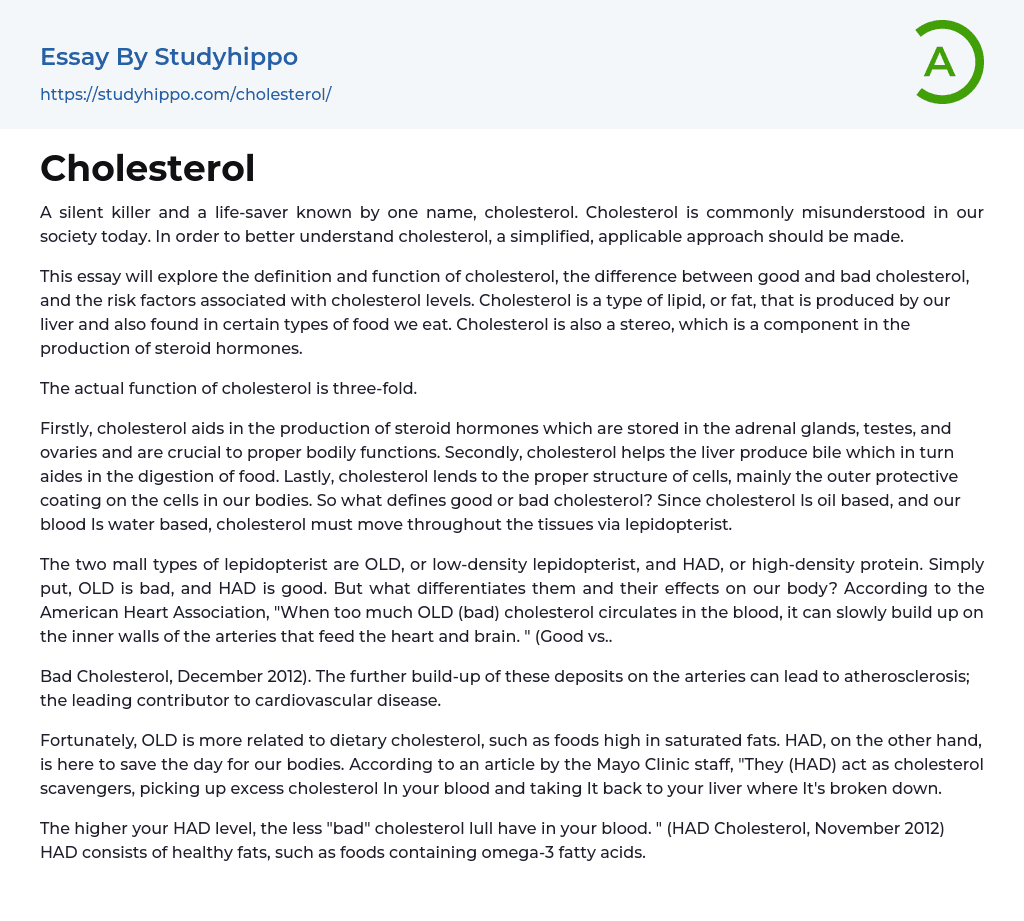A silent killer and a life-saver known by one name, cholesterol. Cholesterol is commonly misunderstood in our society today. In order to better understand cholesterol, a simplified, applicable approach should be made.
This essay will explore the definition and function of cholesterol, the difference between good and bad cholesterol, and the risk factors associated with cholesterol levels. Cholesterol is a type of lipid, or fat, that is produced by our liver and also found in certain types of food we eat. Cholesterol is also a stereo, which is a component in the production of steroid hormones.
The actual function of cholesterol is three-fold.
Firstly, cholesterol aids in the production of steroid hormones which are stored in the adrenal glands, testes, and ovaries and are crucial to proper bodily functions. Secondly, cholestero
...l helps the liver produce bile which in turn aides in the digestion of food. Lastly, cholesterol lends to the proper structure of cells, mainly the outer protective coating on the cells in our bodies. So what defines good or bad cholesterol? Since cholesterol Is oil based, and our blood Is water based, cholesterol must move throughout the tissues via lepidopterist.
The two mall types of lepidopterist are OLD, or low-density lepidopterist, and HAD, or high-density protein. Simply put, OLD is bad, and HAD is good. But what differentiates them and their effects on our body? According to the American Heart Association, "When too much OLD (bad) cholesterol circulates in the blood, it can slowly build up on the inner walls of the arteries that feed the heart and brain. " (Good vs..
Bad Cholesterol, December 2012). The further build-up of these deposits o
the arteries can lead to atherosclerosis; the leading contributor to cardiovascular disease.
Fortunately, OLD is more related to dietary cholesterol, such as foods high in saturated fats. HAD, on the other hand, is here to save the day for our bodies. According to an article by the Mayo Clinic staff, "They (HAD) act as cholesterol scavengers, picking up excess cholesterol In your blood and taking It back to your liver where It's broken down.
The higher your HAD level, the less "bad" cholesterol lull have in your blood. " (HAD Cholesterol, November 2012) HAD consists of healthy fats, such as foods containing omega-3 fatty acids.
- Pregnancy essays
- Death essays
- Asthma essays
- Chronic Pain essays
- Diabetes essays
- Infection essays
- Infertility essays
- Pain essays
- Sexually Transmitted Disease essays
- Cholesterol essays
- Epidemic essays
- Pathogen essays
- Symptom essays
- Water supply essays
- Myocardial Infarction essays
- Chronic essays
- Hypertension essays
- Black Death essays
- Breast Cancer essays
- Down Syndrome essays
- Apoptosis essays
- Tuskegee Syphilis Experiment essays
- Type 2 Diabetes essays
- Addiction essays
- Anatomy and Physiology essays
- Biodegradation essays
- Cancer essays
- Dental Care essays
- Disability essays
- Disease essays
- Disorders essays
- Health Care essays
- Infectious Disease essays
- Inquiry essays
- Intelligence Quotient essays
- Lung Cancer essays
- Medicine essays
- Neurology essays
- Nutrition essays
- Olfaction essays
- Physical Exercise essays
- Public Health essays
- Sex essays
- Women's Health essays
- World health organization essays
- Fat essays




